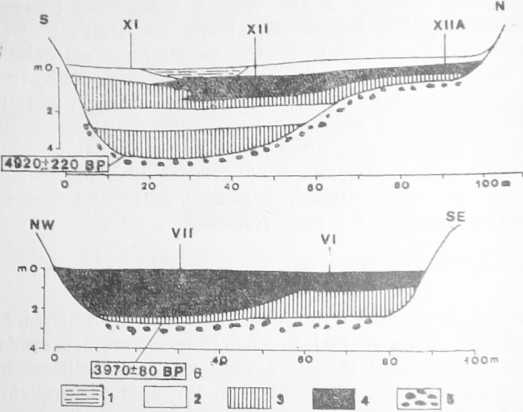DSC07943 (2)
108 T. Sokołowski
dychotomous as described at the San river by Szumański (1972) and expressed in a differentiation of a grain size composition. The materiał of a higher clay content occurs at the bottom while that of silt at the top. These silts exhibit sometimes lamination of the climbing-ripple cross type and horizontal lamination which indicate an increased flood inten-sity.
The abandoned channel deposits constitute the cut-off paleomeander fills. Their thickness is variable (e.g. Fig. 10) and reaches slightly morę

Fig. 10. Schematic cross-sections of paleomeanders 1 — oxbows lakę; 2 — muds; 3 — muds with floral detritus; 4 — peat; 5 — channel deposits; 8 — dates of 14C
than 4 m at maximum. Silts form usually the lowest part of the profile of the abandoned channel fills. They can contain some sand, or morę rarely the plant detritus. Peats, strongly silty, appear above them in some profiles. The grain composition of the abandoned channel silts is almost identical to that of the madas described above (Fig. 6).
FLOOD PLAIN
The flood plain is built mainly of the channel facies consisting of sands, and less freąuently of sands with gravels. Silts admixtures, or even mud inserts, are freąuent. Typical diagonal laminations are pro-nounced here. Horizontal lamination dominates in the lino deposits.
The thickness of these sediments is difficult to be determined. Fine sands, slightly silty occurred at the outcrop near Słupiec (Fig. 1) below
Wyszukiwarka
Podobne podstrony:
Perfect Dctails Pin the facing down around the neckline and then sew it on as describod on the
Plant metaphors for the expression of emotions 13 relationship is regarded as Iow at the beginning o
- 3 - i {As Buffalo at the ena of Maj - for "pretsure on Washington to sup ort tne Polish exil
As every year the presentation of scientific abstracts (orał and posters presentations) will be the
screenshot 4 John Smith This is a description for the user. You can be bold and oblique but it
okolicy. Ocena stopnia zagrożenia. (Amphibian Populations at the Selected Water Bodies of Kraków and
ostatnia wieczerza At the 3a»t suppeę Jesus broke bread and said, "Take thfc and eat it. Hus is
vAct0306Dore StPeterAndStJohnAtBeautifulGate "St. Peterand St. John at the Beautiful Gate"
35047 vibro 24 Weil, whnt <lo you know! Today we rc at the cnd uf our sixth day and can look for-
112 Krzysztof Waliszew ski the futurę will be morę common and gaining in importance. Decision-making
12 tracheal gili system was as yet poorly developed, it mtist have been sluggish and slow in develop
56 A.T. Jankowski Vistula and the Oder basins was estimated in the mid-80s by M. Rogoż, A. Różkowski
STRATEG IC PLANS TO ADDRESS CHALLENGESRcduce CostReview of the ICL contract by both ICL and theTCIG
writin2 irs. His "Ob-ut the coun-d a Pulitzer 182), an au-and Russell In The New es—those
więcej podobnych podstron